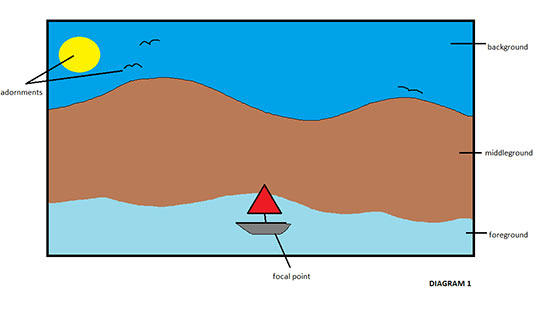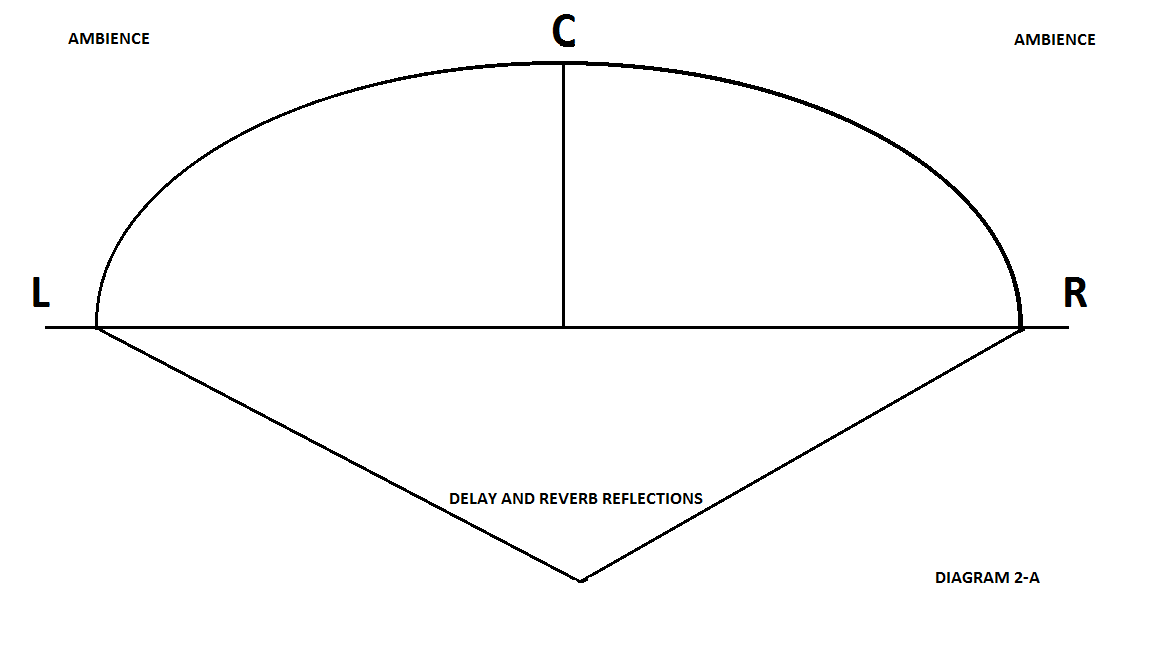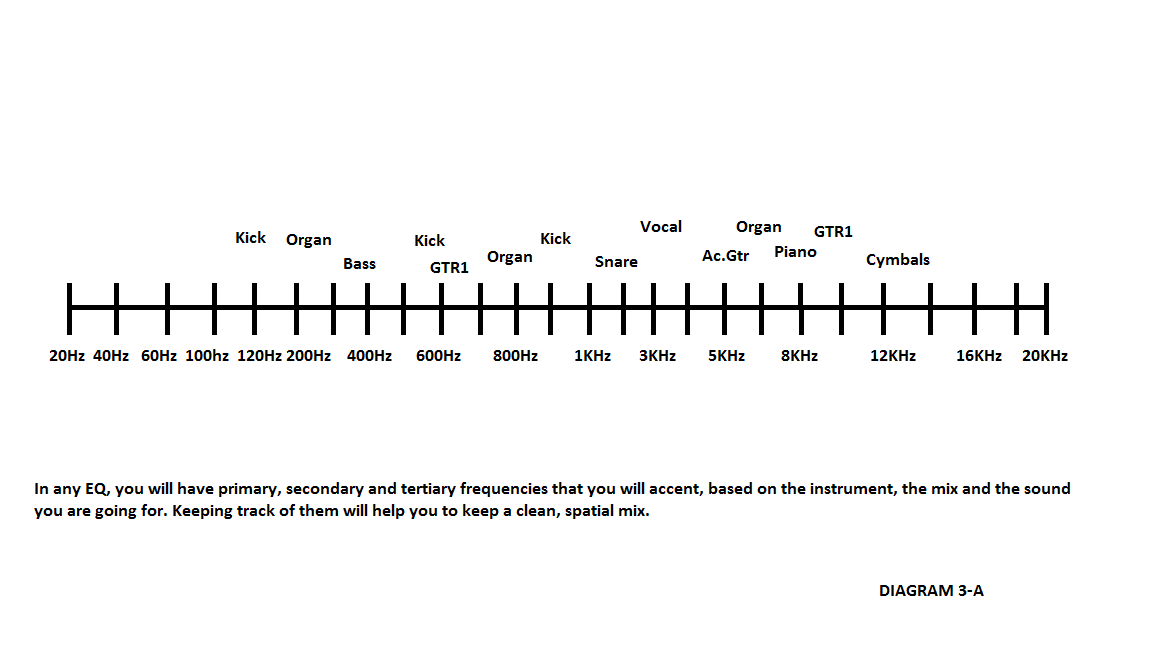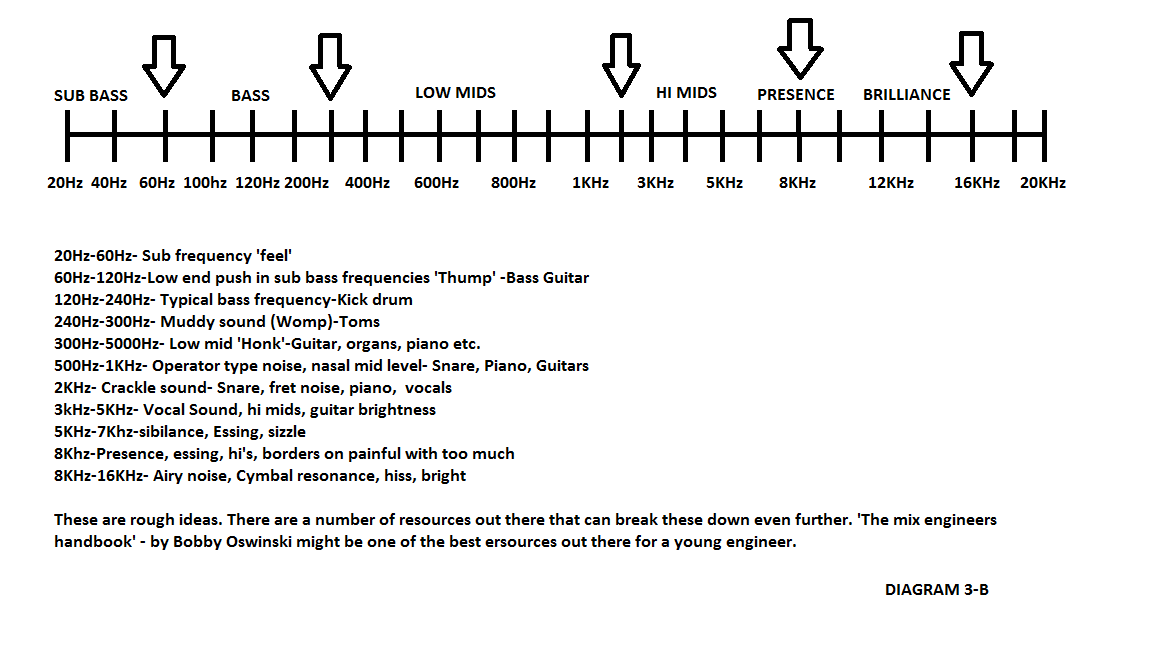- Published Aug 19, 2013 in In The Studio
Producer/Engineer Jami McGraw breaks down the basic ingredients for getting a good mix on your recording.
Whenever you are sitting down to begin a mix, there are a few things you should consider and also be aware of. The song you are about to approach is, in a sense a storyline that you need to bring to life. In the spirit of this, visualize a painting of a landscape. (diagram 1) While this is a crude picture, and perhaps oversimplified, the point remains valid, in that you are setting a scene, telling a story, and providing a front row seat to the artist’s tale. This should not be taken lightly, and should be artfully crafted and sculpted with the utmost respect for the process. Now this does not mean you need to be a weathered engineer to the masses. It DOES, however mean that you need to do what your mama always told you, and put ‘your listening ears’ on!

- Background - in this case, the sky. Creates a contrast to what is there. The picture isn’t about the sky, but the sky being there adds perspective to the boat and mountains. Certainly, there could be a picture of a boat in the water, with mountains in the background without seeing the sky, but the sky creates a realm or space.
- Middle ground - the use of middle ground creates dimension or depth in the space. The contrast between the foreground and a washed background is infinite without the use of a middle ground.
- Foreground - the view nearest and most prominent to the observer, which in most cases frames the focal point.
- Accessory, adornment – additives that are not necessary, but are an interesting seasoning or addition to something in a decorative sense.
- Focal Point - the point that first attracts the eyes of an observer.
If this could be used as a metaphor, please consider the following.
- Background - Room Size (reverb) instrument pad, delay tails
- Middle ground - Rhythm sections, pulse, main hook, wet instrumentations
- Foreground - Dry instruments, lead voicing’s,
- Focal Points - Lead vocals, solo instruments
- Accessories - Fills, personification, (ear candy)
Food for thought.
- Little to no reverb makes an object appear close, lots of reverb makes an object seem far away.
- Compression, when used properly, is like a haircut to your wave file. It trims off the larger spikes, and pushes them down, and takes the smaller spikes, and fluffs them out. This will soften some of the louder parts, and bring out some of the softer parts.
- If one of your components in the mix cannot be heard, try changing its frequency (EQ), or the EQ of the tracks around it. Volume lifting, and ‘fader chasing’ shouldn’t be the first ‘Go To’.
- Start your mix from the ground up. Here is one approach to a basic mix. Kick, Snare, Toms, Overheads, Bass. This completes the Rhythm section. Now seat a vocal in the middle to see how it stands up to the center channel (kick, snare, bass). Then add your other instruments or tracks around it to fill out the space.
- When bringing out a particular frequency on an instrument, you don’t always have to boost that frequency. Sometimes you can achieve the same effect by removing the frequencies around it.
- Don’t be afraid to start over if the mix isn’t happening. Sometimes a clean slate will help you get THE sound you were looking for.
10 simple rules for conquering a mix.
These are certainly not the end all be all, but definitely some helpful things that I learned along the way.
1. Always use a metronome
Period… Use this until you have your main rhythm track down, and it is locked tight, (edit appropriately if need be). From there, build on the instrument that preceded your take. Things must be cohesive. Once the drums/rhythm tracks are done to satisfaction, dump the click and play to the band… Just like playing live, you will need to find ‘the pocket’ with one another.
2. Spread your tracks out
not every track needs to be humping the center of the mix. Let the lead actors play the lead roles. There is no room for EGO in the mix. This rule applies not only to PANAORAMA aka ‘panning’, but to frequencies as well… (Refer to diagrams 2-A & 2-B; and 3-A & 3-B as your jump off.) I have these printed out for myself and fill them in while mixing as my guideline. You’ll be surprised how much this will help your mix).
3. One cook in the kitchen
NEVER listen to the band about their own instrument, the idea is to make it work IN THE MIX, not on SOLO. Never mix an instrument on solo. Yes, you can solo it to gain perspective, but it HAS to work in the mix. Every member of the band is going to refer to their idol, saying, I want my guitar to sound a bit more like Jimi in Purple Haze. Tell him or her politely to get the fuck out of the room, and fetch some coffee or sandwiches. Yes, they should have input, but unless they are immersed in the mix, they are a much bigger help if they are fetching snacks.
4. Don’t feed after midnight
Ok, not really. But be smart. Don’t mix longer than 3 hours, and never for more than 30-45 minutes at a clip. Take a 15-30 minute break in between to give your ears a rest. Everyone has their own approach, but I assure you, beyond that window, all objectivity will be lost, and you will end up doing more harm than good.
5. Beware Narnia
Don’t get lost in minutia. Minutia is a slippery slope to ruining your mix. Vocalists will want to fix that one syllable to that one phrase in the third verse. SHUTUP. Guitar players will want to get the bend to their solo just right, “let’s punch that….” >SLAP< SHUTUP. The bass player will have come up with an awesome new riff after the second chorus… #$%^&* SHUTUP. The drummer will have a new fill to end the song…SHUT…>.<..UP. A good song can be unplugged, acoustic, piano, ska, orchestral, a cappella… Point being, see the forest through the trees boys and girls… Look at the song as a whole. That will give you a different perspective. Don’t get lost in minutia, I mean it… don’t do it.
6. Listen closely
Audition your mixes from various places, on various formats. Listen on your monitors, listen in headphones. Listen in your car. On your iPod; listen in stereo, listen in mono.
Places to check your mix outside of your studio.
- Car with you in it…
- Car with you outside of it, approx. 10’ away
- Home stereo system (any stereo you are familiar with) with you in the room.
- Home stereo with you outside the room.
- Headphones that are not on your head, literally.
7. Take Notes
When listening to your mix make sure you take accurate notes with detailed fixes. For example; verse 2, vocals up a bit; Guitar solo down; Bass is too muddy; Snare is too sharp. The catch is, when you go into your project to fix these, DO NOT TOUCH ANYTHING ELSE. You will be tempted to change other things you hear. DON’T DO IT. Trust your notes. When I make these changes, I don’t even listen to the song. I make the slight changes, bounce and save. That’s it. I can then listen back on a disk or MP3 to see if the tweaks were enough… tomorrow.
8. Don’t overdo it
This applies to everything. The word of the day is Moderation my friends. As much as you will be tempted to add a little more reverb for the ladies, trust me, it doesn’t make you sound better; this will not get you laid. Be smart; don’t listen to the songs too much. You will find yourself losing objectivity. Before mixing, I usually don’t listen to anything from the tracking session for two weeks. This keeps me fresh. Even while mixing, don’t bounce a mix until you have everything roughed in. It will save your ears and perspective. The first mix I audition is usually after I have EVERYTHING in and can go no further. I don’t even listen to roughs during the tracking stages.
9. Catch your balance
When auditioning your final mixes, pick a band or song that is similar in texture, tone and feel, and A-B (compare) it against your mix. That’s not to say copy it, but it will put your mix back into context of reality. This is actually a good practice to do along the way of your mix to help keep you in bounds a bit. While this doesn’t have to be your template, it will help to sober you up and put your mix AND your ears back in focus.
10. Don’t be a jerk
Be open to criticism and suggestion. While it’s fine to cling to the dedicated artist syndrome, it’s easy to get defensive over peoples criticisms. First, don’t play your music for people until you have it complete. Otherwise you’re just setting yourself up for a critique on an unfinished product. Secondly, when it is done, and you DO play it for someone, pay attention to their body language, but don’t ask “So, what do you think”. Yes, you are going to want them to do backflips, but give them some room to digest. Don’t be afraid to leave them with the mix to listen on their own time. They will probably be able to enjoy it more that way without feeling like they are on the spot. Just remember to take their compliments as well as their criticisms in stride. Don’t be that pretentious artist that states “they just don’t get it”. These are your audience members, these are your first fans, and most likely, they are your friends and family too. Never forget that.
It’s easy to lose your footing with so much against you in today’s music world. With the ease of being able to make studio quality music at home, comes the inherent responsibility of being an artist, a tech, an engineer, a producer, a manager, a roadie, a promoter, a social network black belt, an event planner, an accountant, a chauffeur and a groupie… Well, maybe not a groupie, but remember, the most important thing you can be throughout any stage of your career is…. yourself.





